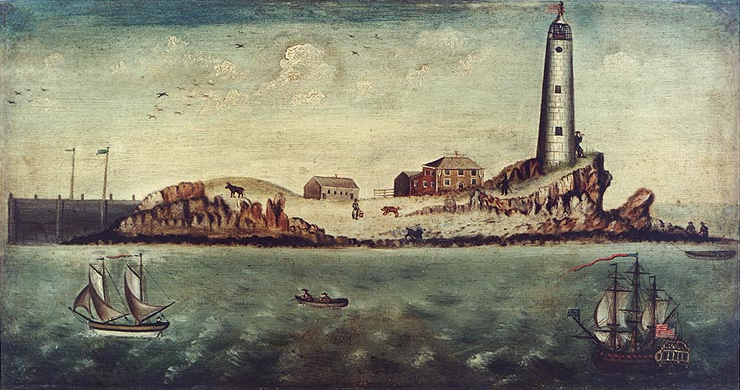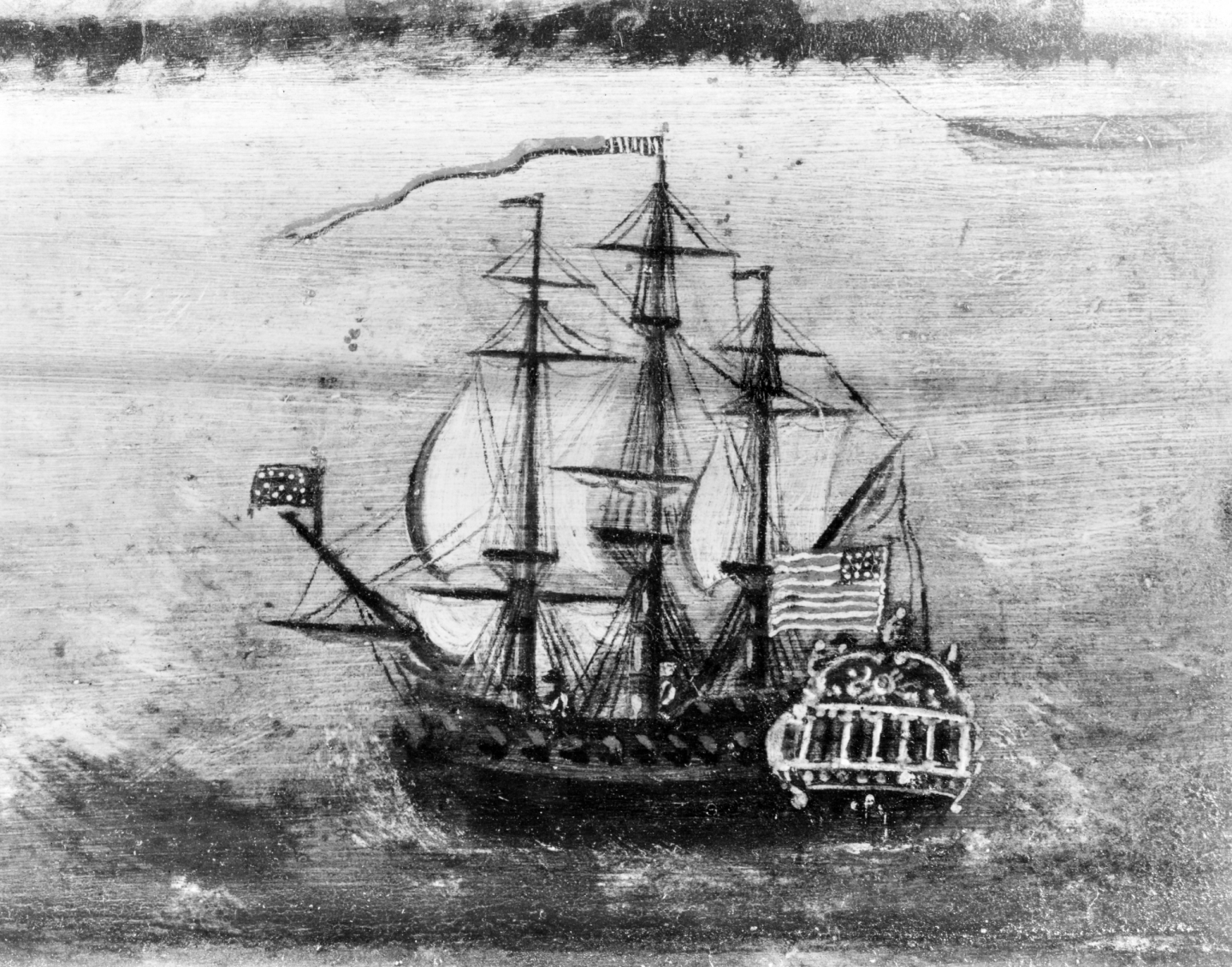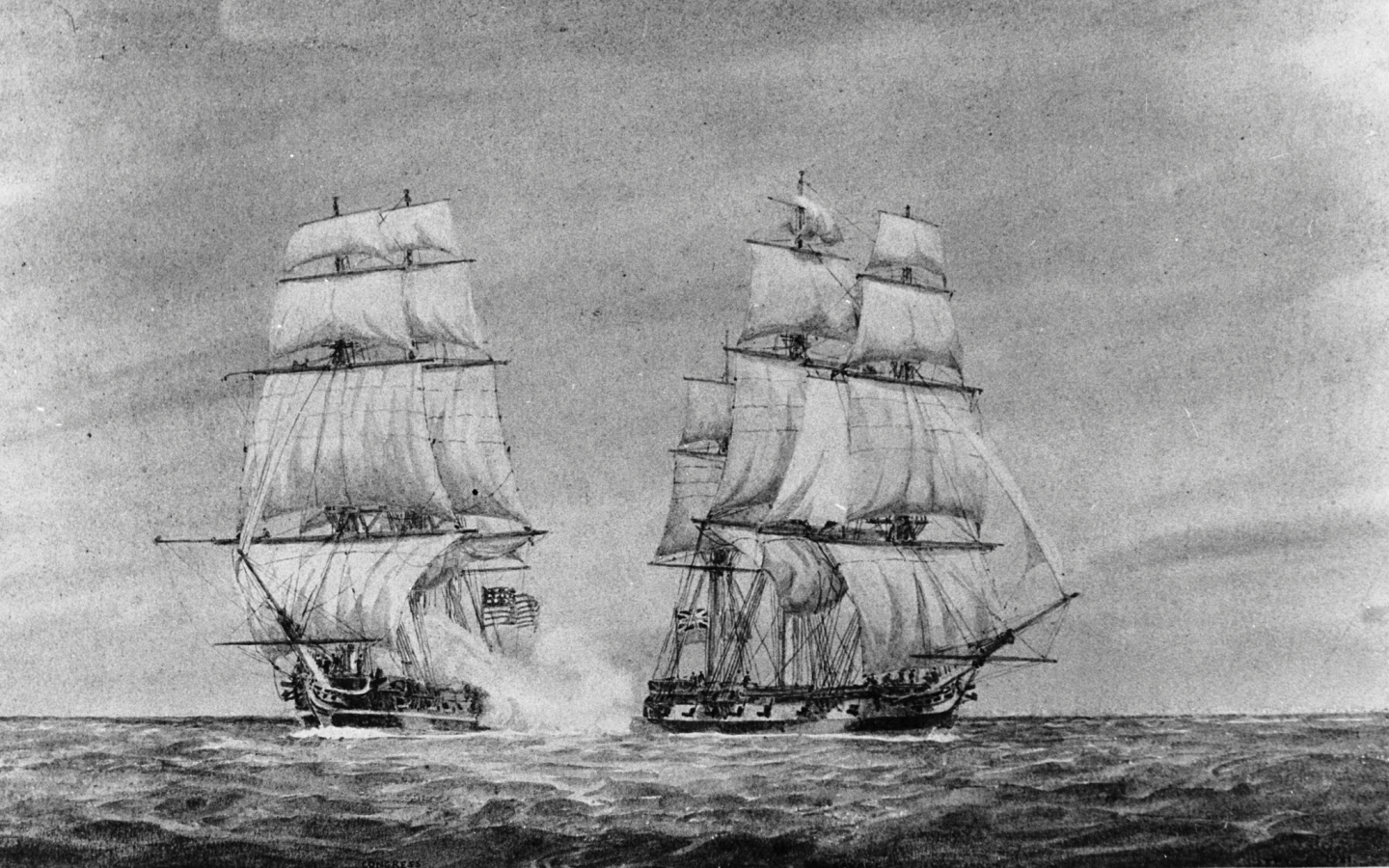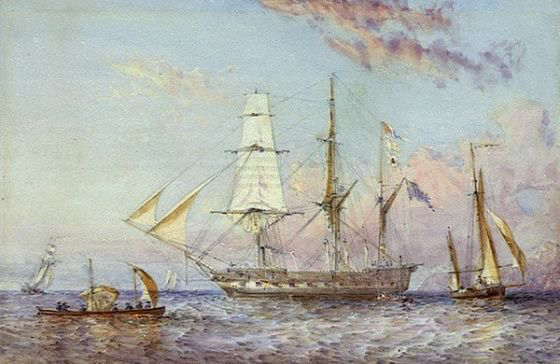-
Posts
2,148 -
Joined
-
Last visited
Content Type
Profiles
Forums
Gallery
Events
Everything posted by uss frolick
-
The British Schooner of War Dominica mounted a 4-pounder brass swivel/cohorn on her capstan when she fought the privateer Decatur in 1813. The Frigate Constitution mounted a seven-barreled swivel Chambers Gun on her capstan when she fought the Cyane and Levant in 1815, for defense against enemy boarders, in addition to additional Chambers guns in her tops. The Privateer Fair American, of the Revolutionary War fame, mounted a large swivel on her capstan, according to the memoirs of one of her crewmen, (Jacob Nagel - who would later sail to Australia in the 'First Fleet) that was used to good effect in defeating an enemy's nighttime boat attack.
-
There was an account I read about a formal evening party thrown on the deck of the new frigate USS Potomac in 1828 while fitting out in Washington. They covered the spar deck with canvass and created a candelabra on the capstan by ringing it with muskets with bayonets fixed. There was a candle placed in each muzzle and this illuminated the spar deck ...
-
Great to see you posting again, Wes. I really like the clean fairing of the cant-frames and hawser timbers. Nice. Interesting that you are working on the stem post. The Essex's stem was, according to Josiah Fox, the only part of the ship, above the waterline, that didn't have to be replaced! I have anecdotal evidence too, that she retained her Indian figurehead ...
-

Stoves/Ovens on ships in the 1600s and Onward
uss frolick replied to acaron41120's topic in Nautical/Naval History
They're not working, (again) and the normal, edit-post tab doesn't appear either ... drat. -

Stoves/Ovens on ships in the 1600s and Onward
uss frolick replied to acaron41120's topic in Nautical/Naval History
The Wasa provides some answers. Her stove was essentially a brick lined wooden box. The archeological drawings: https://live.staticflickr.com/65535/50525123216_c223556a67_b.jpg[url=https://flic.kr/p/2jYJsS5]0[/url] by [url=https://www.flickr.com/photos/165793220@N04/]Stephen Duffy[/url], on Flickr [url=https://flic.kr/p/2jYKieb][img]https://live.staticflickr.com/65535/50525285912_538a1c1d36_h.jpg[/img][/url][url=https://flic.kr/p/2jYKieb]0-1[/url] by [url=https://www.flickr.com/photos/165793220@N04/]Stephen Duffy[/url], on Flickr Edit by MTaylor.. Sorry.. I tried to fiddle with the first one and no joy. Best way is download the photo to your HDD and then use the image attachment (paperclip - lower left hand side). -
Bill Romero told our club a long time ago that the author did not obtain permission to reproduce many of the plans shown in his book, and got sued by multiple persons soon after publication. Sad. Pays to be careful ...
- 4 replies
-
- Milton roth
- lusci
- (and 4 more)
-
Actually, a third Swan-Class sloop fell to the Americans! HMS Thorn was taken by USF Deane (12-pounders) and USF Boston (a mixture of 12-pounders and 9-pounders) . Very few particulars are available about this fight. From the Wiki page on the Frigate Deane: Under the command of Captain Samuel Nicholson of the Continental Navy, Deane sailed from Boston 14 January 1779 with Alliance for a cruise in the West Indies. She returned to Philadelphia 17 April with one prize, the armed ship Viper. On 29 July she joined with USS Boston and two ships of the Virginia Navy guarding a convoy of merchantmen out to sea and continuing on for a five-week cruise which netted eight prizes, including four privateers, the packet Sandwich, and the sloop-of-war HMS Thorn. The frigates arrived at Boston 6 September with 250 prisoners after one of the most notable cruises of the Continental Navy. During the winter and early spring of 1781 Deane cruised with Confederacy and Saratoga in the West Indies. In May, Lloyd's List reported that the rebel frigates Dean and Protector had captured John, Ashburner, master, from Lancaster to St. Kitts, and a ship sailing from Glasgow to Jamaica with 90-0 barrels of beef and a quantity of dry goods, and had taken them into Martinique.[1] Deane again cruised with Confederacy and Saratoga in the West Indies in 1782, capturing four prizes. In April 1782 she captured the cutter HMS Jackal. After two more cruises in the Caribbean, one in September 1782 and the other in 1783, she was renamed Hague in September 1782 (perhaps because of false accusation against Deane that was current at the time). According to Wiki, HMS Thorn became a yankee privateer, was recaptured, and survived until 1816, making her the longest lasting of the Swans (so far)! HMS Thorn (1779) was a 14-gun sloop launched in 1779 that two American frigates, USS Deane and USS Boston captured on 25 August 1779. She became an American privateer with a number of successful engagements and prizes to her name. Arethusa captured her on 20 August 1782.[3] She then returned to service in the Royal Navy, serving until 1816 when she was sold.
-
Savage wasn't the only Swan Class Sloop to tangle with an American. In 1781, the Atalanta was taken by the Continental Frigate Alliance, a ship probably similar the later Essex, which had been produced by the same shipbuilder family, but unlike the Essex, the Alliance was armed with 28 long French 18-pounders that had been earmarked for the lower deck of the lost Bon Homme Richard. HMS Atalanta was sailing in company with another, smaller British sloop of war, HMS Trepassy, both having batteries of only 6-pounders. From Wiki: "During a tempest on the 17th, lightning shattered the frigate's main topmast and carried away her main yard while damaging her foremast and injuring almost a score of men. Jury-rigged repairs had been completed when Barry observed two vessels approaching him from windward 10 days later but his ship was still far from her best fighting trim. The two strangers kept pace with Alliance roughly a league off her starboard beam. At first dawn, the unknown ships hoisted British colors and prepared for battle. Although all three ships were almost completely becalmed, the American drifted within hailing distance of the largest British vessel about an hour before noon; Barry learned that it was the sloop of war HMS Atalanta. Her smaller consort proved to be Trepassey, also a sloop of war. The American captain then identified his own vessel and invited Atalanta's commanding officer to surrender. A few moments later, Barry opened the inevitable battle with a broadside. The sloops immediately pulled out of field of fire of the frigate's broadsides and took positions aft of their foe where their guns could pound her with near impunity In the motionless air, Alliance – too large to be propelled by sweeps – was powerless to maneuver. A grapeshot hit Barry's left shoulder, seriously wounding him, but he continued to direct the fighting until loss of blood almost robbed him of consciousness. Lieutenant Hoystead Hacker, the frigate's executive officer, took command as Barry was carried to the cockpit for treatment. Hacker fought the ship with valor and determination until her inability to maneuver out of her relatively defenseless position prompted him to seek Barry's permission to surrender. Indignantly, Barry refused to allow this and asked to be brought back on deck to resume command. Inspired by Barry's zeal, Hacker returned to the fray. Then a wind sprang up and restored Alliance's steerage way, enabling her to bring her battery back into action. Two devastating broadsides knocked Trepassey out of the fight. Another broadside forced Atalanta to strike, ending the bloody affair. The next day, while carpenters labored to repair all three ships, Barry transferred all of his prisoners to Trepassey which – as a cartel ship – would carry them to St. John's, Newfoundland, to be exchanged for American prisoners. HMS Charlestown recaptured Atalanta in June and sent her into Halifax. Temporary repairs to Atalanta ended on the last day of May, and the prize got underway for Boston. After more patching her battered hull and rigging, Alliance set out the next day and reached Boston on 6 June. "
-
Preserved Killick: "Which I think it's one of the Doctor's high words, a physician he is, with a fine wig, and a silver cane! He wouldn't look at you on land for under five guinies, I'm told ..." Barrett Bonden: "The captain urges us to go forth upon the enemy's deck, I do believe, and convince those fat-arsed, dutch-built buggers of the error of their ways." Killick, "Which then, we shall endeavor to persevere ... Hand me that-there boarding-axe ..."
-
American Captain Geddes: “Huzzah, vicissitude her lads!” I thought about the figurehead too, since no plan is known to survive. But the term ‘savage’ was frequently used at that time to describe the North American Indians, so maybe her head resembled the Essex’s hatchet wielding warrior or the Rattlesnakes knife bearing brother! How ironic if true! since she lasted at least until 1803, when she was finally hulked, that would make her older than even the Fly, which sank in a storm off Canada in 1802! I wonder if either Savage or Fly was ever rearmed with carronades ..,
-
From Edward Stanton McClay's classic "The History of American Privateers", pp. 211-13: "One of the most creditable actions of this war in which an American privateer was engaged took place on September 6, 1781. It had been the habit of the smaller British cruisers stationed on the North American coast to send boat expeditions at night for the purpose of plundering estates along the shore. One of the most persistent English commanders in this questionable style of warfare was Captain Sterling, of the 16-gun sloop of war Savage. About the time mentioned Captain Sterling had been exploring Chesapeake Bay, and on one occasion sent a boat expedition to Mount Vernon and plundered Washington's estate. Soon after the Savage had put to sea from the Chesapeake, and was cruising off the coast of Georgia in search of other estates to plunder, she fell in with the American privateer Congress, of twenty-four guns and two hundred men, under the command of Captain George Geddes, of Philadelphia. Mr. Geddes, as we have noticed, had been a highly successful officer in the privateer service, having two years before commanded the 10-gun brig Holker, in which he made a most creditable record. Upon making out the Congress to be an American war craft of superior force, Captain Sterling made all sail to escape, upon which the Congress gave chase. It was early in the morning when the two vessels discovered each other, and by half past ten o'clock the American had gained so much that she was able to open with her bow chasers, and by eleven o'clock Captain Geddes was close on the Englishman's quarter, when he opened a rapid fire of small arms, to which the enemy answered with energy. Observing that he had the swifter ship of the two, Captain Geddes forged ahead until he got fairly abreast of his antagonist, when a fierce broad- side duel took place. Notwithstanding the American superiority in armament, this fire at close range so injured the privateer's rigging that it became unmanageable, and Captain Geddes was compelled to fall back to make repairs. As soon as he had com- pleted this work, the Congress again closed on the Savage and engaged in a heavy cannon fire. In the course of an hour the Englishman was reduced to a wreck, the vessels at times being so near each other that the men frequently were scorched by the flashes of the opposing cannon; and it is even asserted that shot were thrown with effect by hand. Seeing that the Englishman was reduced to a de- plorable condition, that his quarter-deck and fore-castle were swept clear of men, and that his mizzen-mast had gone by the board, while the mainmast threatened to follow it, Captain Geddes prepared to board and settle the sanguinary conflict on the enemy's decks. Just as the Americans were about to carry out this programme the boatswain of the Savage appeared on the forecastle, and waving his cap announced that they had surrendered, upon which Captain Geddes immediately took possession. The Englishmen's losses, according to their own statements, were eight killed and twenty-four wounded, while those of the Americans were thirty killed or wounded. Among the enemy's killed was Captain Sterling himself, who appears to have fought with the most determined bravery. Unfortunately Captain Geddes was not able to secure his prize, as both vessels were captured by a British frigate and carried into Charleston. The Congress was taken into the British service under the name of Duchess of Cumberland, Captain Samuel Marsh, and was wrecked off the coast of Newfoundland soon afterward while on her way to England with American prisoners. " The same fight - A more modern assessment from Wikipedia: "By 1781 the smaller British vessels blockading Chesapeake Bay were raiding the American coast by means of boat expeditions. One commander involved in the operations was Captain Charles Stirling of the sloop Savage, armed with sixteen 6-pounders. Stirling was noted for having plundered Mount Vernon, the Virginia estate of General George Washington, who was commander in chief of the Continental Army and later the first American president. Shortly after the raid of Mount Vernon, Captain Stirling sailed his ship south. In the early morning of September 6, Savage was escorting a convoy when she encountered the sloop-of-war Congress ten leagues from Charleston. Stirling placed Savage between the merchant vessels and the stranger. American privateers during the Revolutionary War Congress was under the command of Captain George Geddes of Philadelphia, armed with twenty 12-pounders and four 6-pounders, with a complement of 215 officers and men. Its Marines were under the command of Captain Allan McLane of the Continental Army. Congress was returning from Cap-François, Haiti, where McLane had carried dispatches from George Washington to Comte François Joseph Paul de Grasse, commander of a French fleet, appealing for his aid at Chesapeake Bay. When Stirling first saw Congress he sailed towards her, in the hope that she was a privateer of twenty 9-pounder guns that had been raiding in the area. However, when he got closer and saw that she was significantly stronger even than the privateer he thought she might be, Stirling attempted an escape. However, by 10:30 am the Americans came within range and opened fire with their bow chasers. By 11:00 Congress had closed the distance and her crew engaged with muskets and pistols, to which the British replied with "energy". At this point Captain Geddes observed that his ship was faster than that of the enemy so he maneuvered ahead of Savage until almost abreast, in preparation for a broadside. A duel then commenced at extreme close range, during which both ships were heavily damaged. Sailors on both sides were also burned by the flashes of their enemy's cannon. Congress's rigging was torn to shreds during the exchange, which compelled the Americans to stand off for quick repairs. After doing so, they resumed the chase. Congress was swiftly alongside the Savage again and another duel began. The Americans and British fought for about an hour, the combat ending with Savage in ruins. Her quarterdeck and forecastle had been completely cleared of resistance, her mizzenmast was blown away, and her mainmast was nearly gone as well. Geddes felt that this was an opportune time to board the enemy, but just as he was moving his ship in, a boatswain appeared on Savage's forecastle, waving his hat as a sign of surrender. British forces lost eight men killed and 34 wounded, including Captain Stirling; the Americans had 11 killed and around 30 wounded. In his letter reporting on the action, Captain Stirling noted that after he and his men became prisoners, the Americans had treated them "with great Humanity." In America, the capture was widely cheered as payback for the looting of George Washington's home by Captain Stirling and Savage's crew. However, the Americans who boarded Savage never made it back to port. The frigate HMS Solebay recaptured Savage on 12 September, with a prize crew of thirty Americans aboard. Maclay states that the same frigate captured Congress and recaptured Savage. (The London Gazette mentions the recapture of Savage, but not the capture of her captor Congress.) Notes Savage had a broadside of 48 pounds; Congress had a broadside of 132 pounds. (The privateer Stirling thought Congress was would have had a broadside of 90 pounds, or almost twice that of Savage.) Savage also had 90 fewer men on board than Congress. Maclay further states that Congress became HMS Duchess of Cumberland, and on 19 September wrecked during the passage to Newfoundland where a prison ship was waiting to take on the American prisoners. Twenty men died in the incident, though the survivors eventually made it to Placentia, where the Americans were put aboard the ship sloop HMS Fairy and taken to Old Mill Prison in England. This appears incorrect. The court martial record for her loss reports she sailed on 21 September from Placentia and was wrecked on 22 September. The nautical distance between Charleston and Halifax, Nova Scotia, is such that a vessel sailing at a steady 10 knots, a fast pace for a sailing vessel, would take four and a half days, and Placentia lies beyond Halifax, making it extremely improbable that a vessel captured on 12 September at Charleston would be sailing again from Placentia on 21 September, let alone 19 September. Furthermore Duchess of Cumberland was a cutter (or sloop; accounts vary) of 125 tons burthen and 16 guns. Lastly, early in his book, Maclay states that Congress/Duchess of Cumberland was built in Beverley, Massachusetts; Geddes's Congress was a Philadelphia privateer. She may have been a Congress, but if so, she may have been Congress, of eighteen 9-pounders guns, and 120 men, that HMS Oiseaux captured sometime between 16 June and 2 July 1781."
-
OK, I'm obviously getting errors with Flickr once again ...
-
Here is the Rattlesnake model in question, enlarged as much as is possible: [url=https://flic.kr/p/2jRidUp][img]https://live.staticflickr.com/65535/50440982983_554872ab82_b.jpg[/img][/url][url=https://flic.kr/p/2jRidUp]0-2[/url] by [url=https://www.flickr.com/photos/165793220@N04/]Stephen Duffy[/url], on Flickr [url=https://flic.kr/p/2jRifh4][img]https://live.staticflickr.com/65535/50440987603_bfb3e7ffa6_k.jpg[/img][/url][url=https://flic.kr/p/2jRifh4]0[/url] by [url=https://www.flickr.com/photos/165793220@N04/]Stephen Duffy[/url], on Flickr [url=https://flic.kr/p/2jRmPAv][img]https://live.staticflickr.com/65535/50441685021_ea2c812f62_h.jpg[/img][/url][url=https://flic.kr/p/2jRmPAv]0-1[/url] by [url=https://www.flickr.com/photos/165793220@N04/]Stephen Duffy[/url], on Flickr Remember, this was 1920. There were no books available then by Howard Chapelle or Charles Davis. Nobody layman model builder knew of the National Archives resources, and the Admiralty draughts in London were still inaccessible and not yet unclassified. Yet these models were old in 1920 , so what did they use to build them, I wonder. The USS Delaware, 74 model actually looks pretty good.
-
Unfortunately, no. That was painted in 1828, probably long after the USS Rattlesnake was broken up, and way too large vessel carrying 28 guns. The RN had many Rattlesnakes, and that is surely another. But it does sound like a nice painting, however, by Antione Roux, no less. The catalog's author seemed duly impressed with his painting. Here is the Atholl-Class 28-gun ship of the same name, built in 1822, painted by Sir Oswald Walters Brierly. This was probably the ship pictured there.
About us
Modelshipworld - Advancing Ship Modeling through Research
SSL Secured
Your security is important for us so this Website is SSL-Secured
NRG Mailing Address
Nautical Research Guild
237 South Lincoln Street
Westmont IL, 60559-1917
Model Ship World ® and the MSW logo are Registered Trademarks, and belong to the Nautical Research Guild (United States Patent and Trademark Office: No. 6,929,264 & No. 6,929,274, registered Dec. 20, 2022)
Helpful Links
About the NRG
If you enjoy building ship models that are historically accurate as well as beautiful, then The Nautical Research Guild (NRG) is just right for you.
The Guild is a non-profit educational organization whose mission is to “Advance Ship Modeling Through Research”. We provide support to our members in their efforts to raise the quality of their model ships.
The Nautical Research Guild has published our world-renowned quarterly magazine, The Nautical Research Journal, since 1955. The pages of the Journal are full of articles by accomplished ship modelers who show you how they create those exquisite details on their models, and by maritime historians who show you the correct details to build. The Journal is available in both print and digital editions. Go to the NRG web site (www.thenrg.org) to download a complimentary digital copy of the Journal. The NRG also publishes plan sets, books and compilations of back issues of the Journal and the former Ships in Scale and Model Ship Builder magazines.









